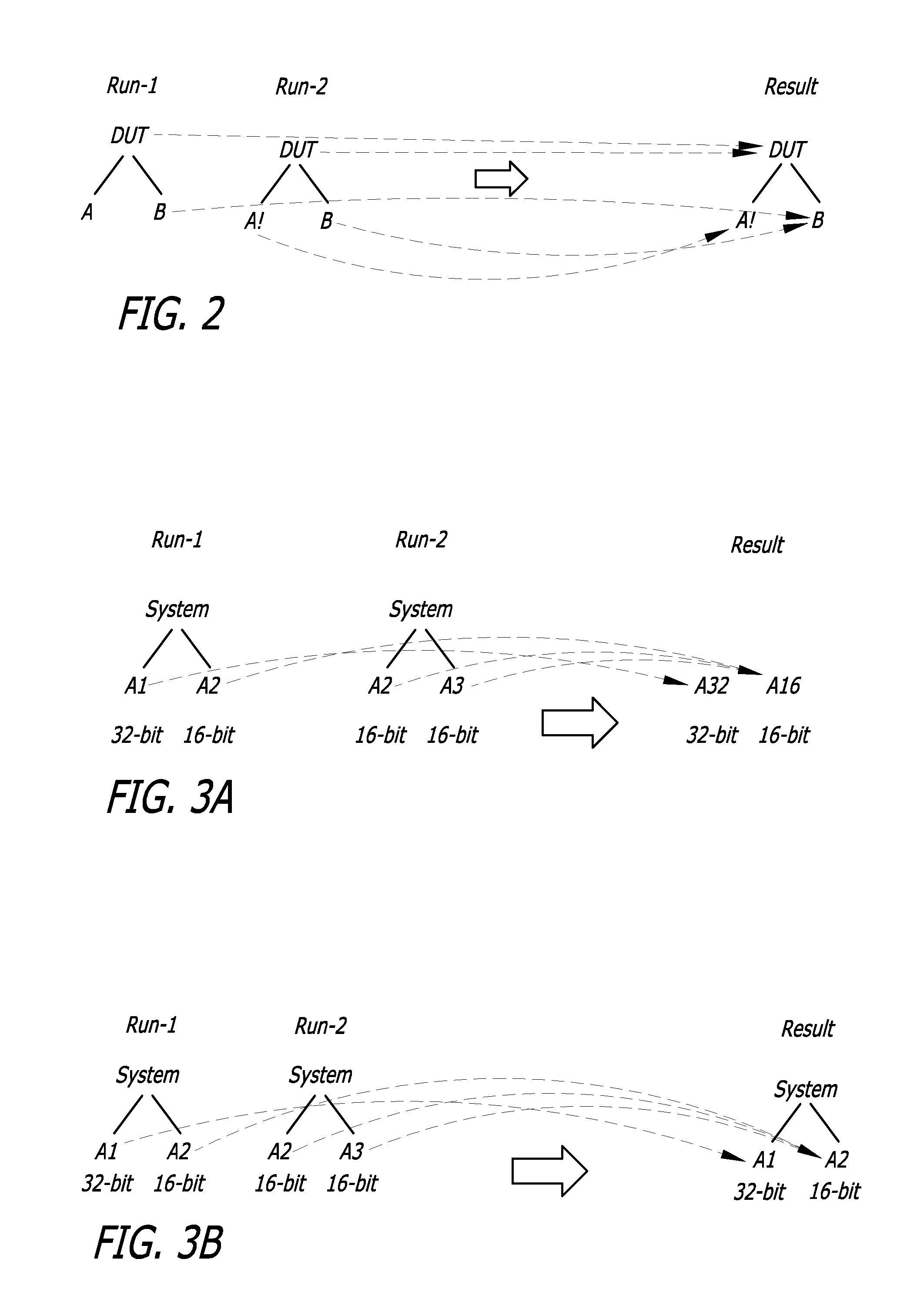Configuration-based merging of coverage data results for functional verification of integrated circuits
a technology of integration circuit design and coverage data, applied in the direction of cad circuit design, program control, instruments, etc., can solve the problems of inflexible prior merging solutions, inability to see or analyze the resulting complete database in the target database context, and inability to meet the requirements of the target database contex
- Summary
- Abstract
- Description
- Claims
- Application Information
AI Technical Summary
Benefits of technology
Problems solved by technology
Method used
Image
Examples
case-1
[0053] Merging when HDL of Same DUT Across Runs is Modified Due to Bug Fixes.
[0054]Usually functional coverage is the primary ingredient of a coverage model at an early stage of verification. Different functional coverage points F are written to cover interesting scenarios, corner cases and error conditions which catch the design bugs. The bugs are fixed in subsequent versions of the DUT. Also fixes or corrections are made in the verification environment.
[0055]FIG. 2 illustrates the scenario where there are two verification runs, Run-1 and Run-2, are merged together into a merged coverage result for the latest version of a device under test (DUT). The verification run Run-2 is run on the latest version of the DUT. The latest version of the DUT includes a module A! that has HDL code changes for bug fixes over that of the prior version of the module A. The prior version of the module, module A has the bugs that needed fixing. To efficiently verify the latest version of the DUT, it is ...
case-2
[0058] Configuration Changes of Different Sub-Blocks Of the DUT and Verification Components.
[0059]Configuration changes of different sub-blocks of the DUT and verification components for the DUT may consist of different sub-blocks. A sub-block may be any configurable design IP (parameterized module).
[0060]FIG. 3A illustrates merging of verification results for a sub-block with different configurations. In a first verification run, Run-1, the system is configured to contain two instances of the same sub-block A (A1 and A2) having different configurations (e.g., a 32 bit configuration and a bit configuration). But in a second verification run, Run-2, the same system is reconfigured and contains two instances of the same sub-block A (A2 and A3) having identical configuration (e.g., a 16 bit configuration). In this case, it is desirable to merge coverage results for the identical component of each sub-block. Coverage results for instances for sub-block A with the 16 bit configuration ar...
case 3
[0082] Bug Fix in DUT and Configuration Change in Verification Environment
[0083]Referring now to FIG. 5, another verification scenario is shown where both the device under test (DUT) and the verification environment undergoes changes. In this case, the test-bench part xbus_demo_tb (a hierarchy rooted under the test top level of hierarchy, ovm_test_top) is configured across runs so that the functional coverage varies across runs. For example, in the first run, Run-1, the functional cover points F1 and F2 are selected while under the second run, Run-2, the functional cover points F1 and F3 are selected in the hierarchy. In this case, the DUT part (the circuit hierarchy rooted at DUT) varies as well over the verification runs due to undergoing bug fixes between runs. For example, Block B in the DUT of the first verification run was corrected to remove a bug and generated corrected Block B! in the DUT in the Nth verification run, Run-N. The register transfer logic (RTL) code representin...
PUM
 Login to View More
Login to View More Abstract
Description
Claims
Application Information
 Login to View More
Login to View More - R&D
- Intellectual Property
- Life Sciences
- Materials
- Tech Scout
- Unparalleled Data Quality
- Higher Quality Content
- 60% Fewer Hallucinations
Browse by: Latest US Patents, China's latest patents, Technical Efficacy Thesaurus, Application Domain, Technology Topic, Popular Technical Reports.
© 2025 PatSnap. All rights reserved.Legal|Privacy policy|Modern Slavery Act Transparency Statement|Sitemap|About US| Contact US: help@patsnap.com



